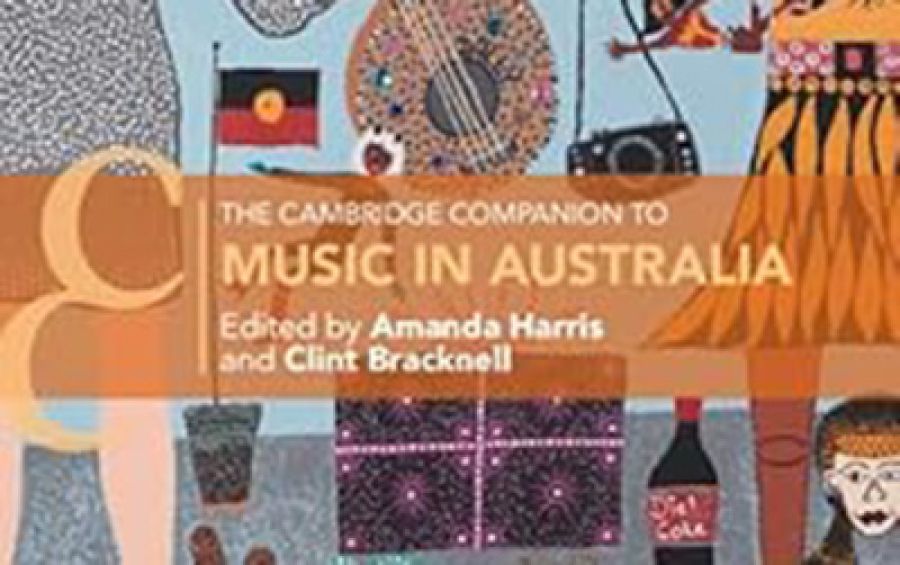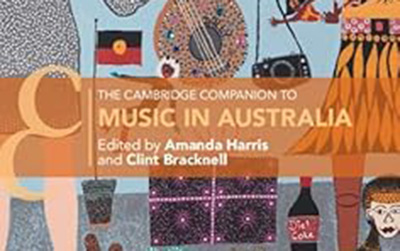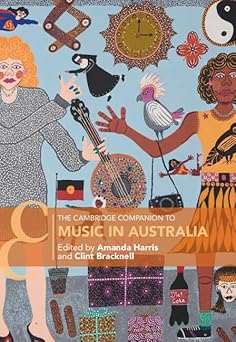
- Free Article: No
- Contents Category: Music
- Review Article: Yes
- Article Title: ‘Make things right’
- Article Subtitle: A significant publishing opportunity missed
- Online Only: No
- Custom Highlight Text:
We all know not to judge a book by its cover but sometimes the temptation to be at least a little influenced by it can be hard to resist. This is especially so when an author (or, in this case, editors Amanda Harris and Clint Bracknell) draws particular attention to it.
- Featured Image (400px * 250px):

- Alt Tag (Featured Image): Peter Tregear reviews ‘The Cambridge Companion to Music in Australia’ edited by Amanda Harris and Clint Bracknell
- Book 1 Title: The Cambridge Companion to Music in Australia
- Book 1 Biblio: Cambridge University Press, £85 pb, 447 pp
- Book 1 Cover Small (400 x 600):

- Book 1 Cover (800 x 1200):

- Book 1 Readings Link: https://www.readings.com.au/product/9781108994002/the-cambridge-companion-to-music-in-australia--2024--9781108994002#rac:jokjjzr6ly9m
This is all admirable framing but it quickly becomes apparent that it does not absolve the editors from still needing to exercise conscious, high level, scholarly judgement. Indeed, arguably the need to make (and make the case for) choices about what aspects of Australia’s musical history and culture should be covered now only becomes more, not less, important. A reader might reasonably expect, for instance, that if the volume is truly to stand as a companion to ‘music in Australia’ it would have to give primary attention to the kinds of music (especially American popular music) that now dominate Australian public and private life. Notwithstanding the conspicuous placement of a banjo and a bottle of Diet Coke on the cover (part of a painting by contemporary Aboriginal Australian artist Kaylene Whiskey), that is not what we find. If anything, the choice of what is covered seems foremost to reflect the diversity of the research interests of the academics who were invited to contribute to its twenty-five chapters.
This tendency towards an inward-facing disciplinary bias must be a standing risk for all Cambridge Companions because their customary structure is to examine a topic through a curated collection of separately authored scholarly essays. In order to present a truly panoramic survey of a topic, the chosen expert contributors have instead to be willing to digest and summarise large amounts of primary and secondary source material in a generous and engaging manner. The institutional system in which they work, however, neither encourages nor easily rewards a scholar who might excel at such generalist, synthetic forms of writing.
The editorial task is thus a tall order from the outset and only more so when the subject of the companion is the musical culture of an entire country-continent (I was not surprised to find that this is only the third volume among the hundred or so published by CUP that tackles such a broad topic). One can understand why similar companions from ‘the other place’ are typically organised, instead, as encyclopaedic dictionaries (see, for instance, The Oxford Companion to Australian Music, published in 1997).
In their opening chapter ‘Introduction and Historiography of Music in Australia’, one of two framing essays the editors contribute to their volume, they at least offer a taxonomy for the grouping of chapters that follow (‘Continuities’, ‘Encounters’, ‘Diversities’, and ‘Institutions’), but I was soon wondering whether they had been conceived more as an afterthought as they appeared to be an editorial bed of Procrustes on which few, if any, of the contributors had originally lain. They also did little to help clarify in my mind why so many other significant aspects of Australia’s musical life had not been considered in depth, if at all.
This is not to suggest that there is little of interest or value to be found in those individual contributions. An early chapter by Aaron Corn and the late Brian Djangirrawuy Gumbula-Garawirrtja (he died in September 2023, but his family have given permission for his name to be used in full for professional purposes) details how the musical cultures of the Yolŋu people of north-eastern Arnhem Land was influenced by encounters with the Makassans and other seafaring peoples in the wider geographic region. It serves as a spirited reminder to the reader that pre-colonisation Australian Indigenous culture (musical and otherwise) were neither static nor completely self-enclosed.
But there is no attempt by the editors to link or build upon this by linking it to other historical perspectives on pre- and post-settlement musical cultures in Australia, and it is a pattern of missed opportunity that is repeated across the companion. For instance, Michael Webb and Christopher Coady’s chapter on ‘The Spiritual in Australia: Practices, Discourse and Transformations, 1879–1950’, and Laura Case and Amanda Harris’s on ‘Cultivating a European Concert Culture in Colonial Sydney and Hobart, 1826–1840’, while containing some fascinating observations, remain temporally, geographically, and thematically insulated from the rest of the volume.
A series of ‘Artists’ Perspectives’, such as Aaron Wyatt and Cat Hope’s essay on their ‘Experimental and Electronic Music in Australia’ or Paul (Mac) McDermott’s on Australian Electronic Dance Music in the 1990s, further emphasises this problem of fragmentary perspectives. A chapter entitled ‘Jazz in Australia – The State of Play’ promised to be more comprehensive but turned out to be only a transcript of a panel conversation of ‘six prominent Australian artists who are commonly identified as jazz musicians’. This is mostly an engaging read, to be sure, but one that constitutionally eschews any pretence to critical distance or scholarly objectivity.
Indigenous Australian composer and multi-instrumentalist William Barton contributes a brief, poignant chapter detailing his experiences as an Indigenous musician performing with non-Indigenous musicians. Yet again, however, the opportunity to encourage the reader to link this discussion to wider emerging themes of Australian musical history and culture was missed, such as when Barton declares, in relation to examples of Indigenous cultural appropriation in the scores of Peter Sculthorpe (a composer who, only a few years ago, might have been expected to be a major focus of such a reference book), ‘You can look at that and say, well, that was then, and this is now, and we’ve got the chance to make things right now.’ Precisely how a non-Indigenous musician might indeed ‘make things right’ is now a pressing question for many Australian musicians across all genres.
Aline Scott-Maxwell and John Whiteoak, in their chapter on ‘Diverse Musics: Shaping Music through cultural Difference’, resist the tendency to be overly narrow in focus. They consider a refreshingly wide array of ethnic musical styles and musicians in Australia, observing how ‘intercultural collaboration’ is ‘increasingly the mode by which cultural diversity is expressed in Australia’. Australia’s multicultural musical identity is the subject of Nicholas Ng, Lu Liu, and Catherine Ingram’s essay on ‘Chinese Music Performance in Australia’ and of Bonnie B. McConnell and Lamine Sonkos on ‘African Musics in Australia’, though here I was again left wondering why the authors didn’t approach the topic more inclusively, and why there were not specific chapters devoted to other major migrant groups.
Kate Bowan’s contribution on early Australian musical modernism, one of only a few that dealt with so-called ‘art music’ culture in Australia, similarly erred towards finer-grain detail than broader observations. Here, I found myself questioning some of her findings. The frequent allusions to the music of Claude Debussy in the compositions of British-Australian composer Fritz Hart, for example, simply does not support Bowan’s contention that, for Hart, continental European influences were something ‘foreign and to be avoided’. Nonetheless, the chapter includes notated music examples, unlike the other chapters.
This was never likely to be a companion that would prosecute its arguments substantially in such an ‘old school’ way. Much of the academic study of music in Australia (and elsewhere) has moved on from notation-centred scholarship and now openly – if not always comfortably – incorporates sociological, economic, ethnographic, and geographical perspectives. A lingering danger for music academics, however, is that along the way the ‘stuff of music’ – its sonic reality, if you like – can correspondingly disappear from scholarly attention. Jadey O’Regan and Tim Byron’s chapter on ‘The Development of the Australian Pop Charts and the Changing Meaning of the “Number One” Single’ discusses the ‘factors that play a role in a song becoming a number one single in Australia’ without connecting such observations in any substantial way to how this music actually sounds. (Here I disagree with the editors, who claim, in their concluding chapter, that ‘there is a danger of music being presented as an aural artefact disjoined from culture and environment’; the danger, I would suggest, is now very much in the other direction.) I also found O’Regan and Byron’s largely uncritical invocation of the ‘music market’, especially in this age of big-data manipulation of consumer behaviour, unwittingly suggestive of the degree to which neo-liberal ideology may be becoming normalised by particular kinds of contemporary musicological discourse.
Amanda Harris’s chapter on ‘Iconic Musical Sites in Australia’ opens the final section of the book (‘Institutions’), with an examination of musical practices associated with two Australian icons: the Sydney Opera House and Uluru. The chapters that follow examine a few Australian music festivals and Australian children’s television music. Inexplicably, other venerable, or at least highly influential, Australian music institutions, such as the network of state-based symphony orchestras, and significant music promoters such as Musica Viva and Live Nation, are not discussed at all.
In the end, the most telling absence in this companion is that of any sustained consideration of the very institutions that have arguably influenced the content of, and methodologies in, the book more than anything else, that is, Australia’s network of research-active conservatoires and tertiary music departments. A hint that things might have been otherwise is given early in the companion when the editors approvingly quote an observation by jazz scholar and musician Bruce Johnson (author of The Oxford Companion to Australian Jazz [1987]) that our once commonplace view of Australian music history as being synonymous with the history of European-style Australian art music reflects the fact that most Australian music scholarship of that time also largely focused on such music. This it did to the ‘consequent exclusion of the full range of jazz, folk, and popular music forms’ as well as, of course, Australia’s Indigenous musical heritage.
The editors do not, however, consider in turn whether similar institutional forces might be shaping the content and directions of Australian musicology today, beyond briefly making some broad observations in the volume’s concluding pages acknowledging Australia’s ongoing ‘systemic, multilayered, covert and overt forms of racism’. They also make a sop to the presumed virtue of identity politics (or is it the presumed inherent ‘whiteness’ of traditional scholarly methodologies?) by noting that ‘it is doubtful that publishers would today accept a survey of music in Australia only written by white academics’.
To my mind, Australia’s musicological institutions are struggling less with how to deal with lingering Eurocentric world views in their midst than they are with simply surviving in a managerial and financial environment that is increasingly hostile to unfettered humanities research tout court. One of those institutions – the Sydney Conservatorium of Music – provided specific financial assistance for this volume, but it also employed almost half of its contributors. In such straitened circumstances, I suspect it is also no longer impolite to wonder which of those facts came first. Whatever the case, we should not be blind to the ways in which the modern political economy of Australia’s universities, and its associated system of research funding and assessment, is shaping what is currently researched and published and how (as well as who gets paid to undertake such research, and where), and thus what is more likely to end up published in a reference work of this kind.
As it stands, this companion is perhaps more revealing about the current state of Australian music scholarship than it is about music in Australia per se. Certainly, it is less than the sum of its parts. For this reason alone, it cannot truly deliver on what both its title, and the wider series into which it falls, otherwise promises. It is a significant scholarly and publishing opportunity missed.


Comments powered by CComment